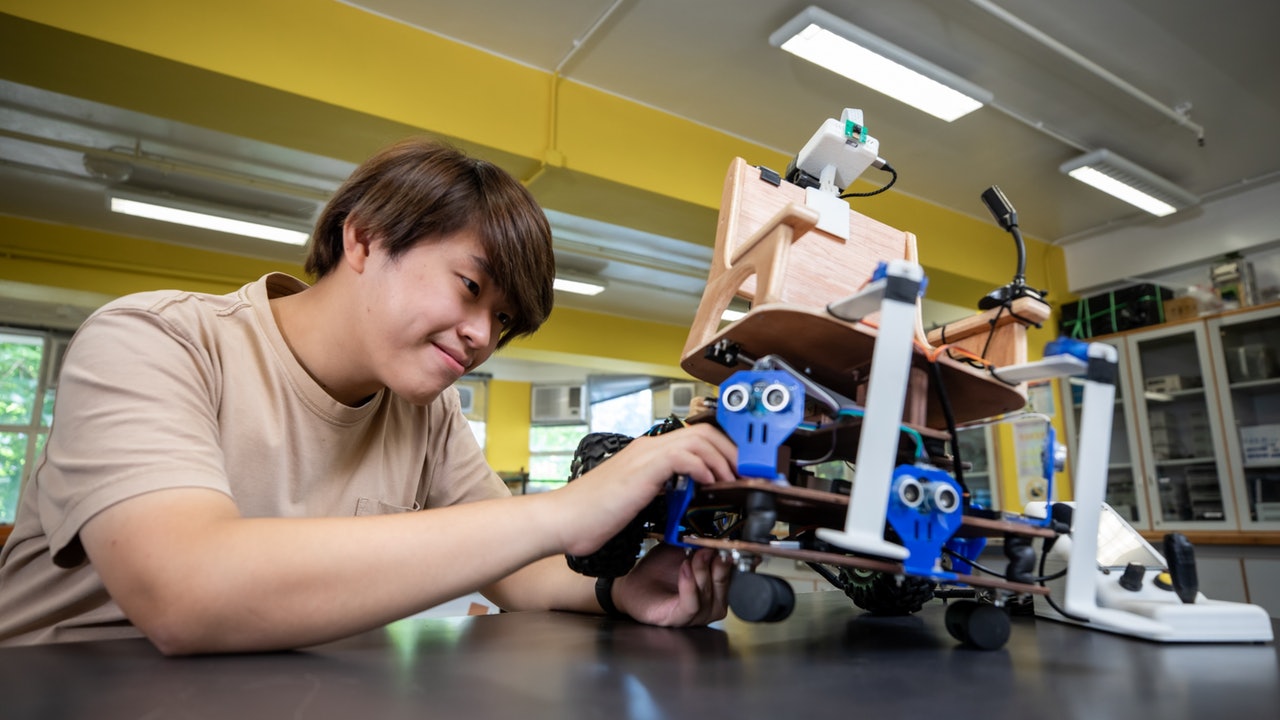18 District News
Author: Contribution
2021-07-12 18:33
Last update date: 2021-07-12 18:33
"I remember watching a movie on the subject of people with disabilities. One of the lines impressed me deeply-"You can't choose not to sit in a wheelchair, but you can choose how to sit", which inspired me to think about how to use engineering knowledge to assist those in need. people."
Written by: Vocational Training Council
IVE Higher Diploma in Computer and Electronic Engineering student Justin Chen participated in the STEM design competition organized by VTC and won the championship with the design of the "smart wheelchair". The picture shows the prototype of the "smart wheelchair".
(Image provided by VTC)
Justin Chen, a student of the Higher Diploma in Computer and Electronic Engineering from the Institute of Professional Education (IVE), uses artificial intelligence (AI) technology to design a "smart wheelchair" with voice functions to help people with mobility impairments automatically avoid obstacles. His work successfully won STEM As the overall champion of the competition, Justin hopes to develop more smart products in the future to help disadvantaged communities.
Inspired by his father's profession, he takes care of the community
"I like engineering. I hope to use technology to help people. It is more or less related to my father's work." Justin's father worked as a trainer in the handicapped workshop, responsible for teaching students simple engineering knowledge and helping them to join the society.
Justin has witnessed how his father practiced and cared for the community since he was a child. He also cultivated an interest in engineering. He said: "Since I was a child, I have assisted my father in preparing teaching materials. He took the opportunity to teach me basic engineering knowledge, such as circuit connections and carpentry. "
After graduating from high school, Justin enrolled in the IVE Foundation Course Diploma (Engineering) to learn engineering knowledge. When he learned that the VTC STEM Education Center held a STEM design competition, he and a few students were eager to try it. Justin bluntly stated that the starting point for conceiving a "smart wheelchair" is very Simply, he said: "When I was studying for the Diploma of Basic Courses, I was first exposed to the knowledge of AI technology and planned to conceive an AI smart wheelchair. It can help others and will be a rare practical experience."
In order to better conceive the functions of the wheelchair, under the introduction of his father, he first communicated with some wheelchair users, and even got on the wheelchair personally to experience the difficulties they face every day. He shared: "I heard that they are most worried about using a wheelchair. Accidents were caused by accidentally hitting people or obstacles. I also shared the inconvenience of getting on and off the wheelchair, requiring manual lifting and lowering of the pedals."
Justin's "smart wheelchair" concept uses AI object recognition technology to identify obstacles near the wheelchair and automatically control the lifting of the pedals to enhance the safety of wheelchair users.
(Image provided by VTC)
The concept of “smart wheelchair” is to use the AI system as the “brain” of the wheelchair. A lens is set in front of the wheelchair, and object recognition technology is used to identify obstacles near the wheelchair. For example, when the lens recognizes a fixed obstacle in front of the wheelchair, AI will The wheelchair is automatically controlled to decelerate or stop. In addition, the wheelchair is also equipped with a voice device. The user only needs to say the keywords "raise" or "lower", and the system will automatically control the foot pedal to rise and fall, which is convenient for users to get on and off the wheelchair. The wheelchair also has a set position and help message function. If the user encounters an accident, just press the "Help" button, and the system will immediately send the help message to family members or carers via the mobile phone program.
Yu Zida (left), a lecturer in the Department of Engineering of IVE (Kejing Huang), pointed out that the IVE course teaches students the professional knowledge related to electronic product design, programming and sensor technology, which helps equip young people like Justin to become engineering technology professionals.
(Image provided by VTC)
The most difficult training AI system to recognize obstacles
It took several months for "smart wheelchair" to develop from concept to prototype. Justin said that the most difficult task is to train the AI system to identify obstacles and define the "safe distance". He said: "To define the difference between obstacles and wheelchairs" The distance between them and when to slow down and stop are all related to programming.” In addition to self-study online, Justin also consults the teacher. After repeated tests, he finally successfully set up the AI system.
Justin's "smart wheelchair" won the championship in the competition, which gave him a boost to his engineering dream. He progressed to the IVE Higher Diploma in Computer and Electronic Engineering last year and continued to learn more about electronic product design, programming and sensor technology. With his professional knowledge, he hopes to go further on the road of engineering. He said: "The "smart wheelchair" still has a lot of improvements. I also hope that with more knowledge, I will develop more products in the future and contribute to society." .
Four-year part-time apprentice full teacher graduates: women have advantages when they are blue-collar
Vocational and technical international courses focused on project study student competition won a prize and conditional admission to a British university
Health and Life Sciences Opportunities IVE Higher Diploma graduated from IVE High Diploma to generate new professionals in chemistry and medical industry
01Community
Vocational Training Council (VTC) People with Disabilities





/cloudfront-eu-central-1.images.arcpublishing.com/prisa/6ECQZUOPKRHVLNAFVOMUMAFZRE.jpg)









